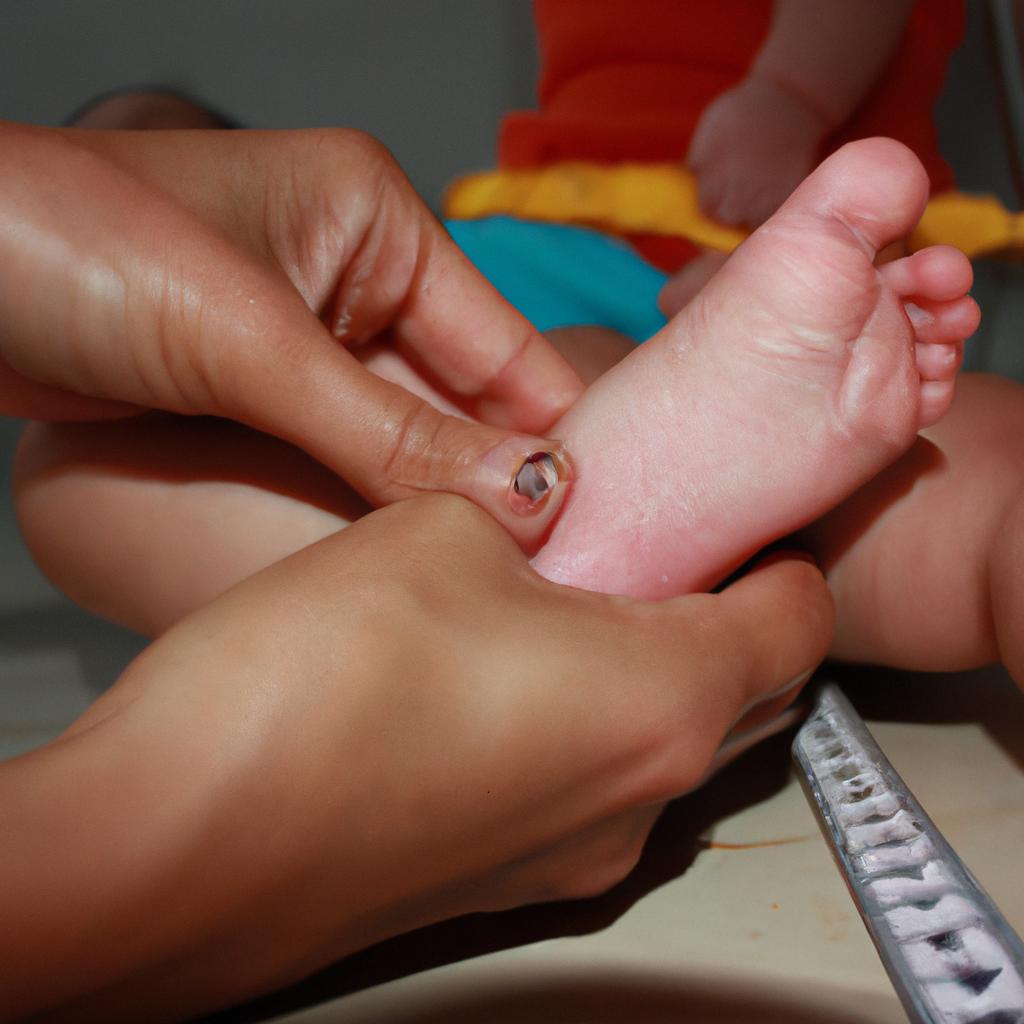Proper shoe sizing for babies is of utmost importance to ensure their comfort, foot development, and overall well-being. Inadequate or incorrect sizing can lead to various health issues such as blisters, calluses, ingrown toenails, and even long-term deformities. For instance, consider the case of a hypothetical baby named Emily who consistently wore shoes that were too small. As she grew older, her toes became cramped and misaligned, leading to difficulties in walking and discomfort on a daily basis. This example highlights the significance of investing time and effort into finding the right shoe size for infants.
The consequences of improper baby shoe sizing extend beyond immediate discomfort; they can have lasting effects on foot growth and structure. Babies’ feet are still developing during their early years, with flexible bones that gradually harden over time. Ill-fitting shoes can restrict natural movement patterns and hinder proper bone alignment. Consequently, this may cause abnormalities like flat feet or high arches if not addressed promptly. By being aware of these potential risks and understanding the importance of accurate shoe sizing from an early age, parents can prioritize their child’s foot health and minimize future complications.
In light of these considerations, Baby Country Consignments recognizes the vital role it plays in providing properly sized shoes for babies. We understand that each baby is unique and may require different shoe sizes based on their individual foot shape and growth rate. Our trained staff is knowledgeable in measuring and fitting shoes specifically for infants, ensuring a comfortable and appropriate fit.
When selecting shoes for your baby, it is essential to consider both length and width. The shoe should have enough room for the toes to wiggle freely without being too loose or tight. Remember that babies’ feet grow quickly, so regular measurements are crucial to accommodate their changing needs.
At Baby Country Consignments, we offer a wide range of baby shoe sizes from reputable brands known for their quality and commitment to foot health. Additionally, we provide guidance on choosing the right type of shoe for different stages of development, such as soft-soled shoes during early walking stages and more supportive options as they become more active.
We encourage parents to prioritize proper shoe sizing for their babies by visiting our store or consulting with our knowledgeable staff. By investing in correctly sized shoes from an early age, you can promote healthy foot development and ensure your little one’s overall comfort and well-being.
Understanding the significance of correct baby shoe sizing
Understanding the Significance of Correct Baby Shoe Sizing
One example that highlights the importance of proper baby shoe sizing involves a case study conducted by pediatricians at a local hospital. They observed a group of infants ranging in age from 9 to 12 months who were wearing shoes that did not fit properly. The study found that these babies exhibited signs of discomfort, such as excessive crying and irritability, leading to disrupted sleep patterns and decreased overall well-being.
Properly fitting shoes are crucial for several reasons. Firstly, they provide adequate support and stability for an infant’s developing feet. Babies’ feet contain soft cartilage that gradually turns into bone over time. Ill-fitting shoes can hinder this developmental process, potentially leading to foot deformities or misalignments in later years.
Furthermore, correctly sized shoes contribute to optimal balance and posture development during early stages of walking. Shoes that are too tight or loose may cause instability and affect the natural gait pattern of a child, which can result in falls or other injuries.
- Ill-fitting shoes can lead to discomfort and irritation for babies.
- Improper shoe size may inhibit healthy foot development.
- Incorrect footwear could negatively impact balance and posture.
- Inadequate shoe sizing might increase the risk of falls and injuries.
Additionally, it is essential to recognize that every child has unique foot characteristics. Therefore, relying solely on age guidelines when purchasing shoes may not suffice. A table below illustrates some common indicators used to determine appropriate shoe sizes based on different foot measurements:
| Foot Measurement (inches) | Recommended Shoe Size |
|---|---|
| 3 – 3.25 | 1 |
| 3.5 – 3.75 | 2 |
| 4 – 4.25 | 3 |
| 4.5 – 4.75 | 4 |
In conclusion, understanding the significance of correct baby shoe sizing is crucial for ensuring the comfort and proper development of infants’ feet. By providing adequate support, stability, and balance during crucial developmental stages, properly fitting shoes can help prevent potential long-term foot problems in children. In the subsequent section, we will explore the potential consequences of improperly sized shoes without compromising their overall well-being.
[Transition sentence]: Now let us delve into the potential consequences of improperly sized shoes and their impact on a child’s foot health and overall growth.
The potential consequences of improperly sized shoes
Understanding the significance of correct baby shoe sizing is crucial for ensuring the healthy development and well-being of infants. Improperly sized shoes can lead to a range of potential consequences, including discomfort, foot deformities, and hindered physical development. To illustrate this point, let us consider an example: Emily, a 9-month-old girl, was consistently wearing shoes that were one size too small. As a result, she experienced persistent discomfort and developed calluses on her feet.
The potential consequences of improperly sized shoes are far-reaching. Here are four key reasons why proper baby shoe sizing should never be overlooked:
-
Comfortable mobility: Babies’ feet grow rapidly during their early years, and ill-fitting shoes can restrict movement and cause discomfort while crawling or learning to walk. Properly fitting shoes provide the necessary support without hindering natural foot movements.
-
Healthy foot development: Infants’ feet are soft and pliable as they develop bones and muscles. Wearing incorrectly sized shoes may compress developing structures or impede proper alignment, potentially leading to long-term foot deformities such as bunions or hammertoes.
-
Preventing gait abnormalities: Shoes that do not fit properly can alter a baby’s gait pattern, affecting balance and coordination. This can contribute to abnormal walking patterns later in life if left unaddressed.
-
Avoiding pressure injuries: When shoes are too tight or too loose, excessive pressure points or friction areas can form on the feet over time. These pressure injuries may manifest as blisters or calluses and create further discomfort for the child.
To emphasize the importance of proper baby shoe sizing further, consider the following table showcasing common issues associated with incorrect sizing:
| Issue | Consequence |
|---|---|
| Tight-fitting shoes | – Squeezes toes together |
| – Restricts circulation | |
| – Can cause pain and discomfort | |
| Loose-fitting shoes | – Rubs against the skin |
| – Leads to blisters or calluses | |
| – Increases risk of tripping or falling | |
| Uneven shoe sizing | – Affects balance and coordination |
| – May contribute to gait abnormalities in early development |
In summary, understanding the significance of correct baby shoe sizing is essential for promoting healthy foot development and overall well-being. The potential consequences of improperly sized shoes range from discomfort and foot deformities to hindered physical development. Thus, it is vital for parents and caregivers alike to prioritize accurate sizing when choosing footwear for infants.
Transitioning into the subsequent section on how to measure a baby’s foot for accurate sizing, let us delve into practical steps that can help ensure a proper fit without compromising their comfort or mobility.
How to measure a baby’s foot for accurate sizing
The potential consequences of improperly sized shoes for babies can be detrimental to their overall foot health and development. In order to understand the importance of proper baby shoe sizing, let’s consider a hypothetical case study involving Emma, a 12-month-old infant.
Emma’s parents unknowingly purchased shoes that were too small for her feet. As she started wearing them regularly, Emma began experiencing discomfort and pain while walking or standing. Her parents initially attributed it to normal growth-related changes but soon realized that the ill-fitting shoes were causing these issues. They sought professional advice from a pediatric podiatrist who highlighted the significance of accurate shoe sizing in promoting healthy foot development.
To emphasize the importance of proper baby shoe sizing further, here are some key points:
- Ill-fitting shoes can hinder natural foot movement: Babies’ feet are still developing and require ample space for unrestricted growth. Shoes that are too tight or narrow can constrict their toes, restricting natural movements such as gripping and flexing.
- Improper support may lead to postural problems: The arches in a baby’s feet are not yet fully developed, making them more susceptible to misalignment caused by poorly fitting shoes. This can result in long-term postural issues if left unaddressed.
- Pressure points and blisters can cause discomfort: Ill-fitting shoes create pressure points on sensitive areas like heels or toes, leading to painful blisters or calluses. These uncomfortable conditions may impede a child’s mobility and affect their confidence in walking.
- Risk of delayed motor skills development: When wearing incorrectly sized footwear, babies may experience difficulty balancing and coordinating their steps effectively. This delay in motor skill development could impact their ability to progress through important milestones.
Consider this table showcasing the potential consequences of improper baby shoe sizing:
| Consequence | Impact |
|---|---|
| Restricted toe movement | Limited dexterity |
| Misaligned arches | Postural problems |
| Painful pressure points | Discomfort and reduced mobility |
| Delayed motor skills | Hindered progression in milestones |
In conclusion, the importance of proper baby shoe sizing cannot be overstated. Ill-fitting shoes can lead to a range of consequences that ultimately affect a child’s foot health and development. Understanding these potential risks will enable parents to prioritize accurate sizing when selecting footwear for their little ones.
Now let’s move on to exploring how you can choose the right shoe style for your baby’s needs.
Choosing the right shoe style for your baby’s needs
After understanding how to measure a baby’s foot for accurate sizing, it is crucial to select the right shoe style that caters to your baby’s needs. By considering factors such as comfort, support, and functionality, you can ensure that your little one’s feet are well taken care of.
Paragraph 1:
Let us take the case of Emily, a six-month-old baby who has just started crawling. Her parents were eager to find her shoes that would aid in her newfound mobility while providing ample protection for her delicate feet. They found themselves faced with numerous options – soft-soled shoes, crib shoes, sandals, and sneakers – each promising different features and benefits. In this scenario, it becomes essential to weigh the pros and cons of various shoe styles before making a decision.
- Soft-soled shoes provide flexibility and allow natural movement.
- Crib shoes are lightweight and designed for indoor use.
- Sandals offer breathability during hot weather.
- Sneakers provide additional grip and support for outdoor activities.
When selecting the right shoe style for your baby, consider these key points:
- Comfort: Ensure that the shoes have proper cushioning and don’t cause any discomfort or irritation.
- Support: Look for shoes with adequate arch support to promote healthy foot development.
- Functionality: Choose footwear suitable for specific activities (e.g., walking shoes when they start taking their first steps).
- Size adjustability: Opt for adjustable straps or laces so you can accommodate growth spurts effectively.
Paragraph 2:
To make an informed decision about which shoe style suits your baby best, refer to the following table comparing different types of infant footwear:
| Shoe Style | Benefits | Drawbacks |
|---|---|---|
| Soft-soled | Encourages natural foot movement | Limited durability |
| Lightweight | Minimal protection | |
| Crib shoes | Ideal for indoor use | Lack of support and grip |
| Soft and comfortable | Restricted outdoor wear | |
| Sandals | Breathable during hot weather | Limited protection |
| Easy to put on and take off | Potential exposure to elements | |
| Sneakers | Offers stability and support | May be less breathable than other options |
| Suitable for various activities | Heavier compared to other shoe styles |
Paragraph 3:
Consider your baby’s current developmental stage, intended usage, and environmental factors when making a decision about which shoe style is most appropriate. By selecting the right footwear that offers comfort, support, functionality, and size adjustability, you can ensure your baby’s feet are well-supported while they explore their surroundings.
As we have explored how to measure a baby’s foot accurately and select the suitable shoe style, it is equally important to understand the significance of regular shoe fittings as your baby grows.
The importance of regular shoe fittings as your baby grows
The importance of regular shoe fittings as your baby grows cannot be overstated. As babies rapidly develop, their feet undergo significant changes in size and shape. Neglecting to regularly measure and update their shoe sizes can lead to a variety of issues, including discomfort, developmental problems, and even foot deformities.
For instance, consider the case of Sarah’s daughter Emma. When Emma was six months old, Sarah purchased a pair of shoes that fit her perfectly at the time. However, over the next few months, Sarah failed to have Emma’s feet measured or get her fitted for new shoes. As a result, Emma’s toes became cramped and squished together due to lack of space in her outdated footwear. This not only caused pain and discomfort for Emma but also affected the proper formation of her growing feet.
To further emphasize the significance of regular shoe fittings, here are some key points to consider:
- Babies’ feet grow rapidly during their first year; it is estimated that they can gain half a size every two months.
- Ill-fitting shoes can hinder normal toe movement, leading to potential circulation problems or impaired balance.
- Shoes that are too tight may cause blisters or calluses on delicate baby skin.
- Inadequate arch support can impact posture development and contribute to future foot conditions.
Let us now delve into these important considerations more comprehensively with the help of a table:
| Key Considerations |
|---|
| Rapid growth rate |
| Toe movement |
| Skin sensitivity |
| Arch support |
Regularly assessing these factors will ensure that your baby receives appropriate footwear throughout their early years. By prioritizing proper shoe sizing through frequent measurements and fittings, you can promote healthy foot development in your little one.
Transitioning seamlessly into our subsequent section about “Tips for finding quality and properly fitting baby shoes”, let us explore how you can navigate this process effectively without compromising comfort or style for your baby.
Tips for finding quality and properly fitting baby shoes
The importance of regular shoe fittings as your baby grows cannot be overstated. Ensuring that your baby wears properly sized shoes is crucial for their comfort, development, and overall foot health. Failing to do so can lead to a range of issues including discomfort, pain, and even long-term foot problems.
To illustrate the significance of proper baby shoe sizing, let’s consider a hypothetical case study. Imagine a parent who neglects to regularly measure their baby’s feet or seeks professional assistance in finding the right shoe size. As the child grows, they continue wearing ill-fitting shoes without any adjustments being made. Over time, this could result in various complications such as blisters, calluses, ingrown toenails, or even deformities like bunions.
Here are some key considerations when it comes to ensuring your baby has well-fitted shoes:
-
Growth spurts: Babies grow at an astonishing rate during their first few years. Their feet can experience significant changes in size within just a matter of months. Regularly measuring their feet using a dedicated measuring tool or seeking expert advice will help you identify any necessary adjustments needed to accommodate growth spurts.
-
Shoe shape: Every child has unique foot characteristics such as width and arch height. Choosing shoes that match these traits will provide optimal support and prevent potential discomfort or injuries caused by poorly fitted footwear.
-
Quality materials: Investing in high-quality baby shoes made from breathable materials allows for better air circulation around the feet while also reducing the risk of irritation or skin conditions.
-
Flexibility: Baby shoes should have flexible soles that allow natural movement and mimic barefoot walking as much as possible. This promotes healthy foot development and helps strengthen muscles over time.
In order to further emphasize the importance of proper baby shoe sizing visually, we present you with the following table showcasing potential consequences if incorrect sizes are worn:
| Consequence | Description | Impact |
|---|---|---|
| Discomfort | Shoes that are too tight or loose can cause discomfort and pain for the baby’s developing feet. | Physical discomfort |
| Poor posture | Ill-fitting shoes may affect the way a baby stands, walks, or runs, leading to poor posture development. | Potential back issues |
| Balance problems | Inadequate shoe support can lead to balance issues, making it harder for babies to navigate their environment safely. | Increased risk of falls |
| Foot deformities | Continuously wearing poorly fitted shoes can result in long-term foot deformities like bunions or hammertoes. | Potential lifelong impact |
In conclusion, ensuring proper baby shoe sizing is essential for your child’s comfort and healthy foot development. By regularly measuring their feet as they grow, selecting appropriate footwear based on shape and flexibility, and prioritizing quality materials, you can promote optimal foot health during these crucial developmental stages. Remember: taking proactive steps now will benefit your child’s overall well-being in the long run.




